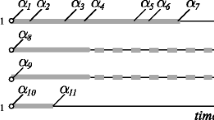Abstract
This survey deals with questions of the organization and structuring of information. Hypermedia models of three basic categories are considered: (1) models of data structures, in which information is laid; (2) models of processes, which describe the semantics of the linking and browsing; and (3) combinational models that include structural and behavioral aspects of hypermedia.
Similar content being viewed by others
REFERENCES
Nelson, T.H., A File Structure for Complex, the Changing and the Interminate, ACM 20th National Conf., Cleveland, 1965, pp. 84–100.
Nelson, T.H., Getting It Out of Our System, in Information Retrieval: A Critical Review, Schelchter, G., Ed., Washington: Tompson Books, 1967, pp. 191–210.
Conklin, J., Hypertext: An Introduction and Survey, IEEE Comput., 1987, vol. 20, no. 99, pp. 17–41.
Fidelio, J., A Grand Vision, BYTE, 1988, vol. 13, no. 10, pp. 237-244, 268.
Epshtein, V.L., Hypertext—A New Paradigm of Programming, Avtom. Telemekh., 1991, no. 11, pp. 3–16.
Franklin, C., Hypertext Defined and Applied, Online, 1989, vol. 37, no. 5, pp. 37–49.
Epshtein, V.L., Hypertext and Hypertext Systems. Preprint of Inst. of Control Sci., Russ. Acad. Sci., Moscow, 1998, p. 39.
Gruzman, V.A. and Epshtein, V.L., Elements of Knowledge Representation and Cognitive Design of Hyperdocuments, in Sb. Trudov IPU Ross. Akad. Nauk (Transactions of Inst. of Control Sci.), Moscow, 1999, pp. 60–75.
Nanard, J. and Nanard, M., Using Structured Types of Incorporate Knowledge in Hypertext, Hypertext' 91, San Antonio, 1991, pp. 329–344.
Campbell, B. and Goodman, J.M., HAM: A General Purpose Hypertext Abstract Machine, Commun. ACM, 1988, vol. 31, no. 7, pp. 836–852.
Halasz, F., Reflections on NoteCards: Seven Issues for the Next Generation of Hypermedia Systems, Commun. ACM, 1988, vol. 31, no. 7, pp. 836–852.
Yankelovich, N., et al., Intermedia: The Concept and the Construction of a Seamless Information Environment, IEEE Comput., 1988, vol. 21, no. 1, pp. 81–96.
Palaniappan, M., Yankelovich, N., and Sawtell, M., Linking Active Anchors: A Stage in the Evolution of Hypermedia, Hypermedia, 1990, vol. 2, no. 1, pp. 47–66.
Furuta, R. and Stotts, P.D., Specifying Structured Document Transformations, Electronic Publishing, Document Manipulation and Typography, Cambridge, 1988, pp. 109–120.
Halasz, F. and Schwartz, M., The Dexter Hypertext Reference Model, Hypotext Standardization Workshop, Gaithersburg, 1990, pp. 95–133.
Gronbaek, K. and Randall, H.T., For a Dexter-Based Hypermedia System, Commun. ACM, 1994, vol. 37, no. 2, pp. 41–49.
Gronbaek, K. et al., Systems: A Dexter-Based Architecture, Commun. ACM, 1994, vol. 37, no. 2, pp. 65–74.
Legget, J.J. and Schnase, J.L., Dexter with Open Eyes, Commun. ACM, 1994, vol. 37, no. 2, pp. 77–86.
Garzotto, F., Paolini, P., and Schwabe, D., HDM—A Model for the Design of Hypertext Application, ACM Trans. Inf. Syst., 1993, vol. 11, no. 1, pp. 1–26.
Knudsen, J.L. et al., Object-Oriented Software Development Environment?The Mjolner Approach, Englewood Cliffs: Prentice-Hall, 1993.
Madsen, O.L., Moller-Pederson, B., and Nygaard, K., Object-Oriented Programming in the BETA Programming Language, Reading: Addison-Wesley, 1993.
Powers, Sh., Expectations, Netscape Enterprise Developer, 1998.
Bogatyrev, P., The Cycle of a Survey, Mir PK, 1997, no. 10, pp. 122–132.
Senichkin, V.I., The Functional Laguage of Conceptual Modeling of Information Systems, Preprint of Inst. of Control Sci., Russ. Acad. Sci., Moscow, 1990, p. 50.
Albano, A., Cardelli, L., and Orsini, R., Galileo: A Strongly-Typed, Interactive Conceptual Language, ACM Trans. Database Syst., 1985, vol. 10, no. 2, pp. 230–260.
Mylopoulos, J. et al., Knowledge Representation in the Software Development Process: A Case Study, Lect. Notes Control Inf. Sci., 1986, no. 80, pp. 23–44.
Nixon et al., Implementation of a Compiler for Semantic Data Model: Experience with TAXIS, SIGMOD Record, 1986, vol. 16, no. 3, pp. 118–131.
Ohori, A., Representing Object Identity in a Pure Functional Language, LNCS, 1990, no. 470, pp. 41–55.
Senichkin, V.I., Informal Introduction to Programming of Problems of Data Processing in the Functional Language, Programmirovanie, 1993, no. 5, pp. 50–69.
Buneman, P. and Nikhil, R., The Functional Data Model and Its Use for Interaction with Databases. On Conceptual Modelling, New York: Springer, 1984, pp. 359–384.
Banchilhon, F. et al., The Design and Implementation of O2, an Object-Oriented Database System, LNCS, 1988, no. 234, pp. 1–22.
Lecluse, C., Richrad, P., and Valez, F.O., An Object-Oriented Data Model, SIGMOD Record, 1988, vol. 17, no. 3, pp. 424–433.
Deux et al., The Story of O2, IEEE Trans. Knowl. Data Eng., 1990, vol. 2, no. 1, pp. 91–108.
Mannino, M.Y., The Object-Oriented Functional Data Language, IEEE Trans. Soft. Eng., 1990, vol. 16, no. 11, pp. 1258–1272.
Gabriel, R.P., White, J.L., and Bobrow, D.G., CLOS: Interacting Object-Oriented and Functional Programming, Commun. ACM, 1991, vol. 34, no. 9, pp. 29–38.
Dannye v yazykakh programmirovaniya (Data in Programming Languages), Agafonov, V.N., Ed., Moscow: Mir, 1982.
Kacmar, C.J. and Leggett, J.J., PROXHY: A Process-Oriented Extensible Hypertext Architecture, ACM Trans. Inf. Syst., 1991, vol. 9, no. 4, pp. 399–419.
Haan, D.J., Kahn, P., Riley, V., et al., IRIS Hypermedia Services, Commun. ACM, 1992, vol. 35, no. 1, pp. 36–51.
Hardman Lynda, Bulterman, D.C.A., and van Rossum, G., The Amsterdam Hypermedia Model: Adding Time and Context to the Dexter Model, Commun. ACM, 1994, vol. 37, no. 2, pp. 50–62.
Bulterman, D.C.A., Specifying and Support of Adaptable Networked Multimedia, ACM Multimedia Syst., 1993, vol. 1, no. 2, pp. 68–76.
Fujikawa, K., Shimojo, S., Matsumura, T., and Miyahara, S., Multimedia Presentation System “Harmony” with Temporal and Active Media, Summer 1991 USENIX Conf., Nashville, 1991, pp. 75–93.
Newcomb, S., Kipp, N.A., and Newcomb, V.T. “HyTime:” The Hypermedia/Time-Based Document Structuring Language, Commun. ACM, 1991, vol. 34, no. 11, pp. 67–83.
Author information
Authors and Affiliations
Rights and permissions
About this article
Cite this article
Gruzman, V.A., Senichkin, V.I. Hypermedia Models. Automation and Remote Control 62, 677–694 (2001). https://doi.org/10.1023/A:1010213803542
Issue Date:
DOI: https://doi.org/10.1023/A:1010213803542




